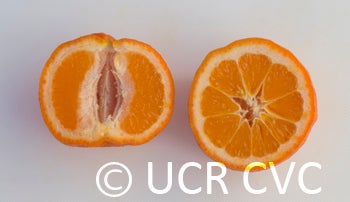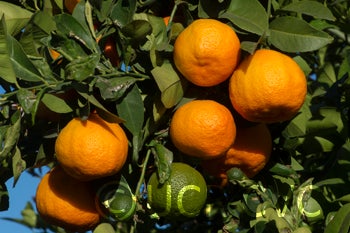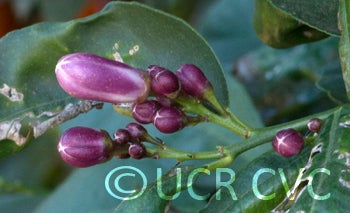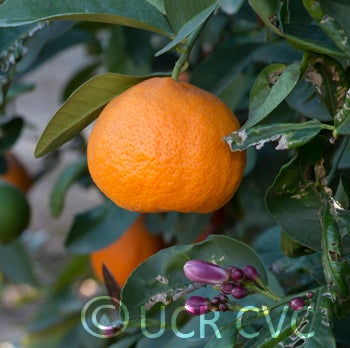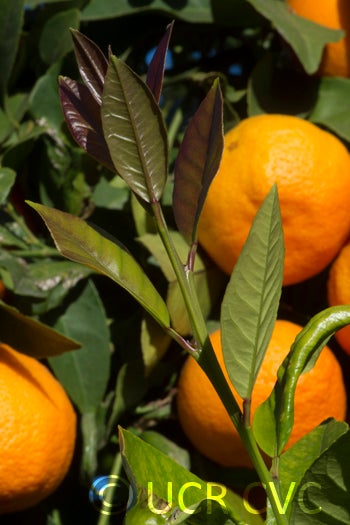Citrus limonia Osbeck
CRC 2709
PI 539343
Source
Received in 1937 from an unknown source.
Parentage/origins
Parents unknown.
Rootstocks of accession
Yuma Ponderosa
Season of ripeness at Riverside
The main crop is winter and early spring.
Notes and observations
Source unknown, same as #2708. This is not same as 2708, rather is Otaheite orange--WPB.
Otaheite is usually referred to as the Otaheite orange, this fruit should be properly regarded as an acidless or sweet form of the Rangpur and therefore would probably be called the Otaheite Rangpur-- from TCI description.
Description from The Citrus Industry Vol. 1 (1967)
"Usually referred to as the Otaheite orange, this fruit should be properly regarded as an acidless or sweet form of the Rangpur and therefore should probably be called the Otaheite Rangpur. The tree is similar to the common Rangpur but less vigorous and hence dwarfed. It is almost thornless and the purple coloration on the new shoot growth is more intense. Likewise, the fruit is similar but somewhat smaller, more commonly necked, contains fewer normal seeds (often none), and is insipidly sweet from lack of acid.
Since an acidless form of the Rangpur is known in India, this fruit doubtless originated there. However, the first known reference to it (Risso and Poiteau, 1818-22, p. 66) described it as Citrus otaitense, a small orange from Otaite (Tahiti) brought to Paris from England in 1813. How or when it reached the United States is not known, but it was listed as a potted ornamental in the 1882 nursery catalog of R. J. Trumble of San Francisco, California (Butterfield, 1963). Easily propagated from cuttings, as are all the Rangpur, it is extensively grown in the United States as a potted ornamental, primarily as a winter house plant. Several unnamed clones are recognized.
Fruit small to medium in size, variable in form but mainly depressed globose to round or broadly obovate; sometimes with furrowed collar or low neck; often with short nipple partially or entirely surrounded by a shallow furrow. Rind color yellowish to reddish-orange; thin, and moderately loose, with surface minutely pitted and smooth to slightly rough. Segments 8 to 10, loosely adherent; axis large and hollow at maturity. Flesh orange-colored; tender, juicy, and strongly acid. Seeds fairly numerous, small, highly polyembryonic, and with light green cotyledons. Fruit holds on tree for a long period.
Tree usually vigorous and productive, medium-sized, spreading and drooping, with slender twigs, comparatively few and small thorns; foliage dull-green and mandarin-like, and new shoot growth lightly purple-tinted. Flowers small and mandarin-like and buds and petals deeply purple-tinged. Hardy to cold.
The description of the Rangpur given above is generalized. Several clonal varieties of this mandarin-like fruit have been selected and named and a comparatively wide variation exists in fruit characters in regard to form, color, smoothness and adherence of rind, and acidity and flavor.
Common names used for the fruit include Rangpur in India, Canton lemon in South China, hime lemon in Japan, cravo lemon in Brazil, Japanche citroen in Java, and Rangpur lime or mandarin-lime in the United States. Other Indian names include Sylhet lime, surkh nimboo, sharbati and marmalade lime. The name lime employed in connection with this fruit is misleading and should be avoided since the only similarities between it and the true limes are that both have small flowers and because they are both highly acid can be used as substitutes.
Resemblances between the Rangpur and mandarin are obvious and numerous, and for this reason it is best included under the mandarin-like fruits. The rough lemon and Rangpur also exhibit rather close similarities and important differences.
Almost certainly of Indian origin, the Rangpur early spread throughout the Orient and to the East Indies. According to Webber (1943), it was introduced into Florida in the late nineteenth century by Reasoner Brothers of Oneco, who obtained seed from northwestern India. The Rangpur is of horticultural importance primarily as a rootstock both in the Orient and South America and as an ornamental.
The clone or clones grown in the United States correspond with the general description given above. It seems probable that one principal clone is involved, since this fruit is highly polyembryonic and reproduces remarkably true from seed. As grown elsewhere, apparently there are several rather similar clones. This appears to be the case in the Orient (Hodgson, Singh and Singh, 1963) and is suggested by the observation of minor differences in a collection of a dozen or more accessions from widely separated sources assembled in California. The differences seem to be concerned principally with the form of the fruit and nature of the rind surface.
In the United States (particularly in California), the Rangpur is widely used as a hardy, dooryard fruit and ornamental and as a potted or tubbed plant. It is especially well adapted for such uses since it propagates readily from cuttings and is easily dwarfed when the roots are confined. Outside the United States, its use seems to be principally as a rootstock. Primarily because of its tolerance to the tristeza virus and resistance to soil-borne diseases, it is a rootstock widely employed, especially in Brazil where it is known as the cravo lemon. When employed for such use, however, the scion materials must be free from exocortis virus, for the Rangpur as a rootstock is severely affected by that disease. "
Availability
Not commercially available in California.
USDA Germplasm Resources Information Network page for Otaheite acidless Rangpur lime

